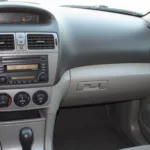The evolution of car technology is a fascinating journey, especially when it comes to engine diagnostics. If you’re a proud VR6 owner, understanding the differences between OBD1 and OBD2 systems is crucial for troubleshooting and maintaining your vehicle’s performance. This article delves into the key distinctions between these systems, their impact on your VR6, and how you can use this knowledge to your advantage.
A Tale of Two Systems: OBD1 and OBD2
Before we dive into the specifics for VR6 engines, let’s clarify what OBD1 and OBD2 are all about. OBD stands for On-Board Diagnostics, a system built into your car’s computer that monitors various engine components and emissions-related systems. Think of it as your car’s internal health checkup system.
OBD1: This earlier system, prevalent in vehicles manufactured before the mid-1990s, was the first step towards standardized diagnostics. OBD1 systems were generally manufacturer-specific, meaning the diagnostic tools and procedures varied significantly between car brands.
OBD2: Introduced in the mid-1990s and becoming mandatory for all US vehicles starting in 1996, OBD2 revolutionized car diagnostics. It brought standardized diagnostic trouble codes (DTCs), connector ports, and data protocols, making it easier for mechanics to diagnose issues across different car models.
The VR6 Connection: How OBD Systems Impact Your Engine
Now, let’s focus on how these OBD systems apply to your beloved VR6 engine. Volkswagen, like many other manufacturers, transitioned from OBD1 to OBD2 in the mid-1990s. This means the specific OBD system your VR6 uses depends on its manufacturing year.
Pre-OBD2 VR6 Engines: These engines relied on OBD1 systems, often utilizing a 2×2 connector port for diagnostics. Troubleshooting these systems could be more involved, often requiring specialized knowledge and tools for accurate diagnosis.
OBD2-Equipped VR6 Engines: With the transition to OBD2, diagnosing issues with your VR6 became more straightforward. The standardized DTCs, accessible through the familiar 16-pin OBD2 connector, provide valuable insights into your engine’s health.
 OBD1 and OBD2 Connectors
OBD1 and OBD2 Connectors
Key Differences Between OBD1 and OBD2 for VR6 Engines
Understanding the differences between OBD1 and OBD2 is crucial for effectively diagnosing and resolving issues with your VR6. Here’s a closer look at the key distinctions:
-
Diagnostic Trouble Codes (DTCs): OBD2 standardized the format of DTCs, making them universally understandable. This means a mechanic or even a DIY enthusiast can quickly decipher the meaning of a specific code, regardless of the VR6’s model year. In contrast, OBD1 systems often used manufacturer-specific codes, making diagnosis more challenging.
-
Connector Port: OBD2 introduced a standardized 16-pin connector port, making it easier to connect diagnostic tools. OBD1 systems, on the other hand, often used various connector types, making finding the correct interface for your VR6 model potentially difficult.
-
Data Richness: OBD2 systems provide access to a broader range of data points from your VR6 engine, including real-time sensor readings, emissions data, and even historical fault information. This comprehensive data allows for more in-depth diagnostics and performance monitoring compared to the limited data offered by OBD1 systems.
-
Emission Monitoring: OBD2 systems are more focused on monitoring and controlling emissions to meet stricter environmental regulations. This means they can detect even minor issues that might affect your VR6’s emissions performance.
FAQs: Addressing Common Queries about OBD1, OBD2, and VR6 Engines
Can I use an OBD2 scanner on my OBD1 VR6?
While both systems share the “OBD” acronym, they are not directly compatible. You’ll need a specialized OBD1 scanner or an adapter to access diagnostic information on an OBD1-equipped VR6.
How can I tell which OBD system my VR6 has?
Check under your VR6’s dashboard for the diagnostic connector port. A 16-pin connector signifies an OBD2 system, while other configurations likely indicate an OBD1 system. Additionally, consulting your vehicle’s owner’s manual or a trusted mechanic can provide clarification.
What are common issues detected by OBD systems in VR6 engines?
OBD systems can detect a wide range of issues in VR6 engines, including misfires, oxygen sensor problems, coolant temperature sensor malfunctions, and more.
Is it worth investing in an OBD scanner for my VR6?
Absolutely! An OBD2 scanner is a valuable tool for any VR6 owner, enabling you to diagnose issues, monitor engine performance, and potentially save on costly mechanic visits.
Navigating the World of OBD: Keeping Your VR6 in Top Shape
Understanding the nuances of OBD1 and OBD2 is essential for any VR6 enthusiast. Whether you’re troubleshooting a check engine light or want to delve deeper into your engine’s performance, knowing which system your VR6 utilizes is the first step. Armed with the right knowledge and tools, you can confidently maintain your VR6 and keep it running smoothly for miles to come.

